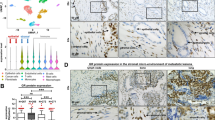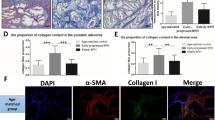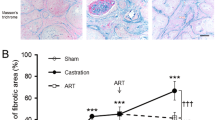Abstract
This study was performed to develop an experimental model in which expression of estrogen receptors (ER) by human prostatic stromal cells could be reproducibly enhanced relative to similar cells with low ER expression. The second aim was to characterise changes in expression of ER, androgen receptor (AR), FGF-2 and FGF-7 in stromal cells exposed to high and low concentrations of estradiol and testosterone mimicking the different sex hormone levels between young and elderly men. Five strains of human prostatic stromal cells, isolated from BPH resections, were grown in steroid-free medium plus 1 μmol 17β-estradiol. After 10 days, cells were passaged and grown in the same medium without estradiol until confluent. In a second study four cell strains were exposed to high and low concentrations of 17β-estradiol and testosterone for 10 days. Cells were labelled with fluorescent antibodies to ERα, AR, FGF-2 and FGF-7 and the fluorescence intensity measured by flow cytometry. Following exposure to 1 μmol estradiol, stromal cells showed reduced expression of AR and ERα but after passage without estradiol they showed a 25% increase in both receptors over controls. Different combinations of sex hormones induced inconsistent changes with respect to expression of ER, AR and FGFs in the various cell-strains. However, there was a highly significant correlation between AR, ER and FGF-2 and FGF-7, which was cell strain-specific. Thus, changes in sex hormone balance per se may not be solely responsible for the observed increases in prostatic ER levels in BPH. Since expression of ER is correlated with synthesis of FGF-2 and FGF-7, it is likely that increases in stromal ER may mediate the synthesis of stromally-derived growth factors which contribute to the aetiopathogenesis of benign prostatic hyperplasia.
This is a preview of subscription content, access via your institution
Access options
Subscribe to this journal
Receive 4 print issues and online access
$259.00 per year
only $64.75 per issue
Buy this article
- Purchase on Springer Link
- Instant access to full article PDF
Prices may be subject to local taxes which are calculated during checkout


Similar content being viewed by others
References
Habenicht U F, el-Etreby M F . Rationale for using aromatase inhibitors to manage benign prostatic hyperplasia. Experimental studies J Androl 1991 12: 395–402
Krieg M, Nass R, Tunn S . Effect of aging on endogenous level of 5 alpha-dihydrotestosterone, testosterone, estradiol and estrone in epithelium and stroma of normal and hyperplastic human prostate J Clin Endocrinol Metab 1993 77: 375–381
Wilson JD . The pathogenesis of benign prostatic hyperplasia Am J Med 1980 68: 745–756
Coffey DS, Walsh PC . Clinical and experimental studies of benign prostatic hyperplasia Urol Clin N Am 1990 17: 461–475
Trachtenberg J, Hicks LL, Walsh PC . Androgen and estrogen receptor content in spontaneous and experimentally induced canine prostatic hyperplasia J Clin Invest 1980 65: 1051–1059
Blanchere M et al. Hormonal regulation of the androgen receptor expression in human prostatic cells in culture J Steroid Biochem Mol Biol 1998 66: 319–326
Collins AT et al. Androgen and oestrogen responsiveness of stromal cells derived from the human hyperplastic prostate: oestrogen regulation of the androgen receptor J Endocrinol 1994 143: 269–277
Ehara H et al. Expression of estrogen receptor in diseased human prostate assessed by non-radioactive in situ hybridization and immunohistochemistry Prostate 1995 27: 304–313
Kirschenbaum A et al. Estrogen receptor messenger RNA in human benign prostatic hyperplasia: detection, localization and modulation with a long-acting gonadotrophin-releasing hormone agonist J Androl 1994 15: 528–533
Kruithof-Dekker IG et al. Elevated estrogen receptor expression in human prostatic stromal cells by androgen ablation therapy J Urol 1996 156: 1194–1197
Byrne R, Leung H, Neal D . Peptide growth factors in the prostate as mediators of stromal epithelial interaction Br J Urol 1996 77: 627–633
Farnsworth WE . Prostate stroma: physiology Prostate 1999 38: 60–72
Steiner MS . Role of peptide growth factors in the prostate—a review Urology 1993 42: 99–110
Smith P et al. Modulating effect of estrogen and testosterone on prostatic stromal cell phenotype differentiation induced by noradrenaline and doxazosin Prostate 2000 44: 111–117
Deshmukh N et al. Differential expression of acidic- and basic fibroblast growth factors in benign prostatic hyperplasia identified by immunohistochemistry Br J Urol 1997 80: 869–874
Saez C et al. Expression of basic fibroblast growth factor and its receptors FGF R1 and FGF R2 in human benign prostatic hyperplasia treated with finasteride Prostate 1999 40: 83–88
Sherwood ER et al. Basic fibroblast growth factor. A potential mediator of stromal growth in the human prostate Endocrinology 1992 130: 2955–2963
Collins AT, Robinson EJ, Neal DE . Benign prostatic stromal cells are regulated by basic fibroblast growth factor and transforming growth factor–beta 1 J Endocrinol 1996 151: 315–322
Ittman M, Mansukhani A . Expression of fibroblast growth factors (FGFs) and FGF receptors in human prostate J Urol 1997 157: 351–356
Leung HY et al. Keratinocyte growth factor expression in hormone insensitive prostate cancer Oncogene 1997 28: 1115–1120
Cunha GR et al. Normal and abnormal development of the male urogenital tract. Role of androgens, mesenchymal-epithelial interactions and growth factors J Androl 1992 13: 465–475
Bodker A et al. Estrogen receptors in the human male prostatic urethra and prostate in prostatic cancer and benign prostatic hyperplasia Scand J Urol Nephrol 1999 33: 237–242
Prins GS et al. Estrogen receptor-beta messenger ribonucleic acid ontogeny in the prostate of normal and neonatally estrogenized rats Endocrinology 1998 139: 874–883
Taylor AH, Al-Azzawi F . Immunolocalisation of oestrogen receptor beta in human tissues J Mol Endocrinol 2000 24: 145–155
Smith P et al. Prostatic stromal cell phenotype is directly modulated by norepinephrine Urology 1998 51: 663–670
Bonnet P et al. Benign prostatic hyperplasia and normal prostate aging: differences in types I and II 5 alpha-reductase and steroid hormone receptor messenger ribonucleic acid (mRNA) levels, but not in insulin-like growth factor mRNA levels J Clin Endocrinol Metab 1993 77: 1203–1208
Bishop MC . Experience with low-dose oestrogen in the treatment of advanced prostate cancer: a personal view Br J Urol 1996 78: 921–928
Yeh S et al. From estrogen to androgen receptor: a new pathway for sex hormones in prostate Proc Natl Acad Sci USA 1998 95: 5527–5532
Planz B et al. Immunolocalization of the keratinocyte growth factor in benign and neoplastic human prostate and its relation to androgen receptor Prostate 1999 41: 233–242
Foster CS, Ke Y . Stem cells in prostatic epithelia Int J Exp Pathol 1997 78: 311–329
Acknowledgements
This study was supported by a research grant from the North West Cancer Research Fund.
Author information
Authors and Affiliations
Rights and permissions
About this article
Cite this article
Smith, P., Rhodes, N., Ke, Y. et al. Upregulation of estrogen and androgen receptors modulate expression of FGF-2 and FGF-7 in human, cultured, prostatic stromal cells exposed to high concentrations of estradiol. Prostate Cancer Prostatic Dis 5, 105–110 (2002). https://doi.org/10.1038/sj.pcan.4500571
Received:
Accepted:
Published:
Issue Date:
DOI: https://doi.org/10.1038/sj.pcan.4500571
Keywords
This article is cited by
-
Sex-dependent variation in cartilage adaptation: from degeneration to regeneration
Biology of Sex Differences (2023)
-
Prostatic microenvironment in senescence: fibroblastic growth factors × hormonal imbalance
Histochemistry and Cell Biology (2014)
-
Relationship between upregulated oestrogen receptors and expression of growth factors in cultured, human, prostatic stromal cells exposed to estradiol or dihydrotestosterone
Prostate Cancer and Prostatic Diseases (2004)



